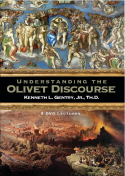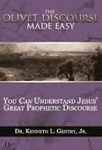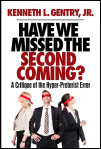THE CONFUSED, STUMBLING DISCIPLES
PMW 2024-014 by Kenneth L. Gentry, Jr.
I am researching an expansion of my The Olivet Discourse Made Easy book. My expansion is so far-reaching in scope and large in size that I may have to rename it. Perhaps, The Olivet Discourse Made Hard. [1]
In my research I have a large section showing how confused and stumbling were Jesus’ twelve disciples — despite having the best teacher possible! Their confusion plays a large role in their misunderstanding Jesus’ prophecy of the destruction of the temple (Matt. 24:2). They ask two questions of him, the second of which shows their confusion. They ask when shall these things be, then they ask what shall be the sign of your parousia and of the end of the age (Matt. 24:3). As per much first century Jewish and apocalyptic expectations, they believed the temple could not be destroyed without history ending and that the Messiah would wage war against pagans.
So, Jesus corrects them by sorting out the issues in his Olivet Discourse (technically known as the Eschatological Discourse). The very structure of his answer shows he is distinguishing the temple’s destruction from the “parousia and the end of the age,” that is, AD 70 from the Second Advent. I will be demonstrating the two part division in the Olivet Discourse in my book. Part 1 deals with AD 70 (Matt. 24:4–31) and then after the transition (Matt. 24:32–36) part 2 deals with the parousia at the end of history (Matt. 24:37–25:46).
But back to work….
The most tragic confusion of the disciples is their inability to understand that Jesus had come into this world for the express purpose of dying and rising again from the dead. And their confusion arises despite the fact he expressly tells them this on three different occasions. And these begin only after he has accepted the title “Christ,” i.e., “Messiah (Matt. 16:15–20): Matthew 16:21; 17:22–33; and 20:17–19). And after each episode we see their confusion and Jesus’ teaching in response. Let’s briefly consider each episode.
Understanding the Olivet Discourse 
By Ken Gentry
This 5 DVD lecture set was filmed at a Bible Conference in Florida. It explains the entire Olivet Discourse in Matt. 24–25 from the (orthodox) preterist perspective. This lecture series begins by carefully analyzing Matt. 24:3, which establishes the two-part structure of the Discourse. It shows that the first section of the Discourse (Matt. 24:4–35) deals with the coming destruction of the temple and Jerusalem in AD 70. This important prophetic event is also theologically linked to the Final Judgment at the end of history, toward which AD 70 is a distant pointer.
For more educational materials: www. KennethGentry.com
Matthew 16:21
“From that time Jesus began to show His disciples that He must go to Jerusalem, and suffer many things from the elders and chief priests and scribes, and be killed, and be raised up on the third day.”
This is dramatically clear statement from their Master given to the disciples alone. They were not distracted by large crowds pressing in on them. But because he repeatedly charges them with being of “little faith” (Matt. 6:30 [2]; 8:26; 14:31; 16:8), we should not be surprised that they stumble badly in their response. Notice Peter’s response and Jesus’ rejoinder:
“Peter took Him aside and began to rebuke Him, saying, ‘God forbid it, Lord! This shall never happen to You.’ But He turned and said to Peter, ‘Get behind Me, Satan! You are a stumbling block to Me; for you are not setting your mind on God’s interests, but man’s’” (Matt. 16:23).
Whoa! That is one severe rebuke! Then immediately after and in response to this, Jesus teaches his disciples the life-threatening cost of following him, a cost that virtually matches his own death: “Then Jesus said to His disciples, ‘If anyone wishes to come after Me, he must deny himself, and take up his cross and follow Me. For whoever wishes to save his life will lose it; but whoever loses his life for My sake will find it’” (Matt. 16:24–25).
Matthew 17:22–23
“And while they were gathering together in Galilee, Jesus said to them, ‘The Son of Man is going to be delivered into the hands of men; and they will kill Him, and He will be raised on the third day.’”
So, once again, a very clear, unambiguous, direct statement regarding his approaching death and resurrection. But let’s look at the preceding narrative context to see what is going on here (I follow narrative criticism over redaction criticism).
Just before this, Jesus casts out a demon that his disciples were unable to cast out. So, they come to him perplexed and disappointed: “the disciples came to Jesus privately and said, ‘Why could we not drive it out?’” Jesus explains that it was because of “the littleness of your faith” (Matt. 17:20) – this problem is the very source of their constant misunderstanding and confusion. Then in that following narrative context we immediately read something quite insightful.
Though they are “grieved” that Jesus said he would die (Matt. 17:23b), they quickly show they have not really understood Jesus teaching. For we read: “At that time the disciples came to Jesus and said, ‘Who then is greatest in the kingdom of heaven?’” (Matt. 18:1). Jesus had just taught that he was going to be killed. But they were wondering which one of them was going to be the greatest in the kingdom! And we know they still did not understand his approaching death and resurrection because they do not believe it until after it happens (John 20:9).

Olivet Discourse Made Easy (by Ken Gentry)
Verse-by-verse analysis of Christ’s teaching on Jerusalem’s destruction in Matt 24. Shows the great tribulation is past, having occurred in AD 70, and is distinct from the Second Advent at the end of history.
See more study materials at: www.KennethGentry.com
Matthew 20:17–19
“As Jesus was about to go up to Jerusalem, He took the twelve disciples aside by themselves, and on the way He said to them, ‘Behold, we are going up to Jerusalem; and the Son of Man will be delivered to the chief priests and scribes, and they will condemn Him to death, and will hand Him over to the Gentiles to mock and scourge and crucify Him, and on the third day He will be raised.’”
Here he explains that not only will he die, but his death will be an aggravated suffering. He will be mocked and scourged! And that by Gentiles! And what does the context of this passion announcement record for us — immediately? Matthew’s narrative strategy has him immediately record for us: “Then the mother of the sons of Zebedee came to Jesus with her sons, bowing down and making a request of Him. And He said to her, ‘What do you wish?’ She said to Him, ‘Command that in Your kingdom these two sons of mine may sit one on Your right and one on Your left’” (Matt. 20:20–21).
Clearly, the disciples simply were not “getting” Jesus’ teaching! He speaks of his approaching cruel death, but two of his disciples have their mother request a place of prominence for them in his kingdom! Though the mother of John and James asks the question, the other disciples are angry with John and James. This shows that the brothers were responsible for their mother’s request.
Have We Missed the Second Coming:
A Critique of the Hyper-preterist Error
by Ken Gentry
This book offers a brief introduction, summary, and critique of Hyper-preterism. Don’t let your church and Christian friends be blindfolded to this new error. To be forewarned is to be forearmed.
For more Christian educational materials: www.KennethGentry.com
Conclusion
In my book I will devote an entire chapter to the disciples’ tendency to misunderstand Jesus (e.g., Matt. 8:23–27; 15:15–20; 16:7–11; 16:16–23). This problem is noted by most scholars.[3] And recognizing this problem takes us a long way to seeing how they were confused in responding to Jesus’ prophecy of the coming destruction of the temple. In fact, the first thing Jesus says when the disciples ask him their two questions (Matt. 24:3) shows his concern with their tendency to confusion: “And Jesus answered and said to them, ‘See to it that no one misleads you’” (Matt. 24:4).
Today the semi-gnostic hyperpreterist movement is confusing scores of earnest Christians. Stumbling at the outset of the Olivet Discourse is one part of the problem.
Notes
1. I got this idea from a financial transaction I made in my 20s. I bought a motorcycle that sold for three easy payments and one incredibly hard payment. So I know how this easy/hard stuff works.
2. Though the Matthew 6:30 reference is taken from the Sermon on the Mount, Jesus is expressly teaching his disciples. For the Sermon opens with this announcement about the setting: “When Jesus saw the crowds, He went up on the mountain; and after He sat down, His disciples came to Him. He opened His mouth and began to teach them, saying…” (Matt. 5:1–2). However, apparently many in the crowds followed and listened, for we read in Matthew 7:28: “When Jesus had finished these words, the crowds were amazed at His teaching.”
3. In Jeffrey Gibbs’, Jerusalem and Parousia (ch. 6) we find abundant material showing the dullness of the disciples even in their question in Matt. 24:3: “In general terms, then, the ‘track record’ of the disciples in Matthew’s story signals the implied reader to distance himself or herself from the eschatological point of view reflected in the disciples’ double question of 24:3….” And “simply put … the disciples in Matthew’s Gospel consistently ‘get it wrong,’ both in general and specifically with respect to eschatological realities” (p. 180). Thus, in his study of another Gospel, R. T. France notes that “Mark’s irreverent portrayal of the disciples as dull-witted and slow to understand is often noticed.” He observes that after Jesus’ announcement of his death, it is “immediately followed by a response from the disciples which reveals their complete failure to come to terms with what Jesus is saying” (Divine Government, p. 49). Jeannine K. Brown wrote her entire doctoral dissertation on Matthew’s presentation of the disciples’ continual confusion: The Disciples in Narrative Perspective: The Portrayal and Function of the Matthean Disciples (Leiden, Netherlands: Brill, 2002). See also: David E. Garland, A Theology of Mark’s Gospel: Biblical Theology of the New Testament (Grand Rapids: Zondervan Academic, 2015), ch. 9 and Kik, Eschatology of Victory, 84ff. If you do not believe them, just ask me!
 Why I Left Full-Preterism (by Samuel M. Frost)
Why I Left Full-Preterism (by Samuel M. Frost)
Former leader in Full Preterist movement, Samuel M. Frost, gives his testimony and theological reasoning as to why he left the heretical movement. Good warning to others tempted to leave orthodox Christianity.
See more study materials at: KennethGentry.com
Kenneth L. Gentry Jr.'s Blog
- Kenneth L. Gentry Jr.'s profile
- 85 followers



